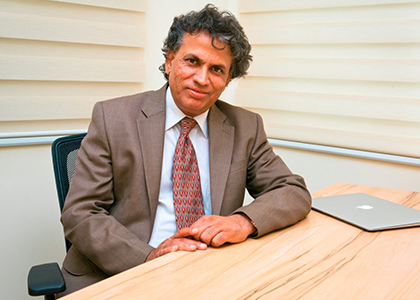What is Cognitive Behavioral Therapy (CBT)?
Cognitive Behavioral Therapy (CBT) is an organised, short therapy that helps in finding and changing the adverse thoughts and actions causing emotional pain and physical problems such as long-lasting pain. It is based on the idea that people’s thoughts and behaviour impact how they feel and the intensity of pain they have. It helps change unhelpful thoughts and actions in individuals so that they may feel better while handling their pain.
The Principles of CBT
CBT operates on several core principles:
- Identifying Negative Thoughts: The first step in CBT is recognising negative and distorted thought patterns that exacerbate pain.
- Challenging Negative Beliefs: Once harmful thoughts are identified, patients are taught how to challenge and reframe them.
- Behavioural Modification: CBT involves teaching healthier coping strategies and behaviours that reduce pain sensitivity.
- Relaxation and Stress Management: Techniques like deep breathing and progressive muscle relaxation are employed to reduce the physical tension associated with pain.
How CBT Differs from Other Therapies
This is not like traditional therapies, as it does not just consider the emotions that come with the pain. It views the issue of long-term pain from a holistic point of view, where the aspect of mind and body comes into play. This approach gives patients an active role in managing their own pain by means of self-awareness and practical methods instead of using medication alone. The difference in CBT with other forms of treatment, whether it is physical therapy or medicines, is that it may not directly intervene in physical pain but modulates perception and processing through the brain.
Looking for trusted psychiatrists in Bangalore? Cadabam’s Hospitals delivers expert, tailored care for a wide range of psychiatric conditions.
Get Chronic Pain Diagnosed in Bangalore
For people with chronic pain, diagnosis is critical before starting the treatment process. The person first has to talk to a healthcare provider and know what is causing the pain. A full check usually consists of the following:
- Medical History Review: Gathering information about past injuries, conditions, and family history.
- Physical Examination: Evaluating the affected area and testing for physical signs of pain or dysfunction.
- Diagnostic Imaging: X-rays, MRIs, or CT scans may be used to detect issues like joint degeneration, nerve damage, or musculoskeletal problems.
- Psychological Assessment: Chronic pain often has a psychological component, so assessing mental health is also crucial.
By getting an accurate diagnosis, patients can better understand their condition and begin effective treatment, such as CBT, to manage their pain.
The Role of CBT in Treating Chronic Pain
Cognitive Behavioral Therapy (CBT) plays a significant role in the treatment of chronic pain. Instead of merely masking the pain through medication, CBT helps individuals adjust their thinking and behaviours to reduce pain perception and improve their quality of life.
Is CBT Effective for Chronic Pain Management?
Research shows that CBT can be highly effective for managing chronic pain. Studies indicate that it helps reduce pain intensity, improve physical function, and enhance emotional well-being. By teaching patients to reframe their thoughts, CBT helps break the cycle of pain and suffering. It is particularly effective for conditions like:
Combining CBT with Other Treatments for Chronic Pain
CBT is most effective as an adjunct to other interventions, such as physical therapy, medication, and alterations in lifestyle. Team efforts that combine CBT with:
- Physical therapy: Will improve movement and ability.
- Pain medications: Controls the physical issues.
- Mindfulness practices: It reduces stress and emotional distress.
The holistic treatment plan will cover all aspects of chronic pain, which leads to better overall outcomes.
Engaging Family and Support Systems in the CBT Treatment Process
The involvement of family members and support systems is crucial to the success of CBT. Chronic pain not only impacts the individual suffering from it but also the person’s family and friends. Bringing family members into therapy can provide them with the support to offer emotional support, assist with new coping skills, and improve the overall quality of life for the patient in general. Treatment also becomes more effective through learning how to help someone with chronic pain.
Tailoring CBT to Individual Needs
CBT is a flexible type of therapy that can be changed to fit what each patient needs. Pain management plans can be made based on the kind of pain, how strong it is, and how the person feels emotionally. A personal approach makes sure that the therapy is useful and works well, dealing with the special problems each patient has.
Support Systems and Environment at Cadabam’s
Cadabam’s is a leading treatment centre in Bangalore, offering the perfect treatment environment for those seeking support for coping with chronic pain through CBT therapy. The holistic approach at Cadabam’s integrates CBT along with other therapies to deliver an entirely comprehensive treatment programme.
Support systems, such as family involvement and continuing counselling, form an important part of the care offered at Cadabam’s so that patients can receive well-rounded and effective treatment.
Psychologists in Bangalore at Cadabam’s Hospitals deliver expert, individualized care for a wide range of mental health conditions.
What to Expect in a CBT Session for Chronic Pain
During a typical CBT session for chronic pain, the therapist will work with the patient to:
- Identify negative thought patterns related to pain.
- Discuss coping strategies and relaxation techniques.
- Practice exercises that promote emotional and physical well-being.
- Review progress and make necessary adjustments to the treatment plan.
Each session is focused on empowering the individual to take control of their pain through practical strategies and self-awareness.
Why Choose CBT for Chronic Pain Treatment?
CBT offers numerous advantages as a treatment for chronic pain, making it a preferred choice for many individuals in Bangalore.
Benefits of CBT Therapy for Chronic Pain Patients
- Non-invasive: CBT does not involve surgery or medication, making it a safe and effective option for managing chronic pain.
- Long-term benefits: CBT addresses the underlying thoughts and behaviours contributing to pain, leading to lasting improvements.
- Improved mental health: By reducing anxiety, depression, and stress, CBT enhances emotional well-being and quality of life.
- Increased self-management: CBT teaches patients how to manage pain independently, giving them more control over their lives.
Real-Life Impact of CBT on Chronic Pain Patients
Many patients have responded with a reduction in the levels of pain and emotional improvements following CBT for chronic pain. They have learned better ways to manage their pain, reduce medication dependence, and lead more fulfilling lives. Testimonials and case studies highlight how CBT has transformed the lives of people with chronic pain and enhanced physical and emotional well-being.
Whether you need therapists in Bangalore, Cadabam’s Hospitals ensures expert care tailored to your needs.
Long-Term Success with CBT for Chronic Pain
CBT enables the patient to be successful in the long run because it teaches them how to manage their problems. While medications provide temporary relief, CBT shows patients how to manage pain over time. Resilience is fostered by the therapy, and the patients are empowered to cope with their chronic pain confidently without relying on external interventions for a long time.
When Should You Ask for Help?
If chronic pain is affecting your daily life, it is important to seek help sooner rather than later. CBT is most effective when started early in the course of chronic pain. The sooner treatment is initiated, the better the chances for long-term success. If you experience persistent pain that is not improving with traditional treatments, or if you are struggling with the emotional toll of chronic pain, it may be time to consider CBT.
Find the Best CBT Treatment Center for Chronic Pain in Bangalore
While searching for CBT treatment for chronic pain in Bangalore, one has to select the best centre with an excellent success track record. The best centres have qualified therapists, excellent facilities, and an all-inclusive, tailor-made approach towards chronic pain management.
Experienced counsellors in Bangalore at Cadabam’s Hospitals provide personalized support for a wide range of mental health concerns.
Why Choose Cadabam’s?
Cadabam’s is one of the best treatment centres in Bangalore that specialises in CBT for chronic pain. It takes a holistic approach to pain control by offering CBT and other therapies within a healing space.
Expert Team of Psychiatrists and Therapists for Chronic Pain
The team at Cadabam’s consists of very well-trained psychiatrists and therapists who specialise in chronic pain. They have an exceptionally strong knowledge of the mental and physical parts of chronic pain, which helps in the best care possible for the patients.
State-of-the-Art Facilities at Cadabam’s for Chronic Pain
Cadabam’s has excellent facilities for chronic pain patients that create a comfortable healing environment. This includes private therapy rooms, relaxation spaces, and all the amenities that would ensure that patients feel supported through the treatment journey.
Integrating Holistic Therapies for Chronic Pain at Cadabam’s
At Cadabam’s, CBT is integrated with other therapies, such as physical therapy, mindfulness practices, and nutrition counselling, to provide a well-rounded approach to chronic pain management. This holistic model ensures that all aspects of pain are addressed, leading to better outcomes.
Continued Care and Follow-Up Programs for Chronic Pain at Cadabam’s
Cadabam’s offers chronic pain care and follow-up programs. This ensures the patients become successful in time and keeps giving them continuous support. Regular follow-up is conducted to assess the patient’s condition, and the treatment plan is modified if necessary.
Cognitive Behavioral Therapy is a strong and holistic method for managing chronic pain. To the people of Bangalore, choosing the right rehabilitation centre, such as Cadabam’s, ensures that they receive expert care in modern facilities and full support in managing pain.
Top Chronic Pain Doctors at Cadabam’s Hospitals
Psychiatrist in Bangalore | Psychiatrist in Hyderabad | Psychologist in Bangalore | Psychologist in Hyderabad | Therapist in Bangalore | Therapist in Hyderabad | Counselor in Bangalore | Counselor in Hyderabad
Rehabilitation Centres For Chronic Pain at Cadabam’s Hospital
Rehab in Bangalore | Rehab in Hyderabad
Best Chronic Pain Treatments Offered at Cadabams
Rehab in Hyderabad | RTMS Hyderabad | physioTherapy Bangalore | RTMS Bangalore | physioTherapy Hyderabad | online Therapy Bangalore | Group Therapy Bangalore | Family Therapy Bangalore | Biofeedback Hyderabad | Biofeedback Bangalore | REBT Hyderabad | Neurofeedback Hyderabad | CBT Bangalore | PsychoTherapy Hyderabad | Neurofeedback Bangalore | Emergency Bangalore | Group Therapy Hyderabad | CBT Hyderabad | Emergency Hyderabad | Direct Cranial Stimulation Bangalore | Direct Cranial Stimulation Hyderabad
More Additional Resources About Chronic Pain
The Connection Between Chronic Pain and Depression: What You Need to Know | How OCD and Chronic Pain Are Linked: Causes, Symptoms, and Solutions | Addressing Anxiety and Chronic Pain: Comprehensive Care Strategies
FAQ
How does CBT help in treating chronic pain?
CBT is utilised to reframe negative thought patterns, manage emotional distress, and promote coping mechanisms, which assist in reducing the perception of chronic pain and improving overall quality of life.
Which CBT techniques are used for chronic pain?
Techniques such as cognitive restructuring, mindfulness-based stress reduction, and behavioural activation are employed to address pain-related thoughts, reduce stress, and enhance daily functioning.
What does a typical CBT session look like?
A structured approach is followed where thought patterns and behaviours linked to chronic pain are explored, practical coping strategies are developed, and progress is monitored over time.














 Available
Available
















